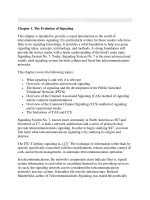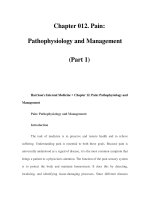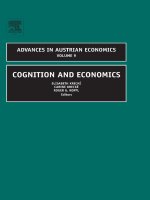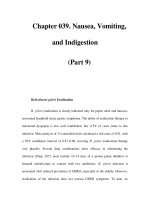Chapter 107. Transfusion Biology and Therapy (Part 1) ppsx
Bạn đang xem bản rút gọn của tài liệu. Xem và tải ngay bản đầy đủ của tài liệu tại đây (13.07 KB, 5 trang )
Chapter 107. Transfusion
Biology and Therapy
(Part 1)
Harrison's Internal Medicine > Chapter 107. Transfusion Biology and
Therapy
Blood Group Antigens and Antibodies
The study of red blood cell (RBC) antigens and antibodies forms the
foundation of transfusion medicine. Serologic studies initially characterized these
antigens, but now the molecular composition and structure of many are known.
Antigens, either carbohydrate or protein, are assigned to a blood group system
based on the structure and similarity of the determinant epitopes. Other cellular
blood elements and plasma proteins are also antigenic and can result in
alloimmunization, the production of antibodies directed against the blood group
antigens of another individual. These antibodies are called alloantibodies.
Antibodies directed against RBC antigens may result from "natural"
exposure, particularly to carbohydrates that mimic some blood group antigens.
Those antibodies that occur via natural stimuli are usually produced by a T cell–
independent response (thus, generating no memory) and are IgM isotype.
Autoantibodies (antibodies against autologous blood group antigens) arise
spontaneously or as the result of infectious sequelae (e.g., from Mycoplasma
pneumoniae) and are also often IgM. These antibodies are often clinically
insignificant due to their low affinity for antigen at body temperature. However,
IgM antibodies can activate the complement cascade and result in hemolysis.
Antibodies that result from allogeneic exposure, such as transfusion or pregnancy,
are usually IgG. IgG antibodies commonly bind to antigen at warmer temperatures
and may hemolyze RBCs. Unlike IgM antibodies, IgG antibodies can cross the
placenta and bind fetal erythrocytes bearing the corresponding antigen, resulting in
hemolytic disease of the newborn, or hydrops fetalis.
Alloimmunization to leukocytes, platelets, and plasma proteins may also
result in transfusion complications such as fevers and urticaria but generally does
not cause hemolysis. Assay for these other alloantibodies is not routinely
performed; however, they may be detected using special assays.
ABO Antigens and Antibodies
The first blood group antigen system, recognized in 1900, was ABO, the
most important in transfusion medicine. The major blood groups of this system are
A, B, AB, and O. O type RBCs lack A or B antigens. These antigens are
carbohydrates attached to a precursor backbone, may be found on the cellular
membrane either as glycosphingolipids or glycoproteins, and are secreted into
plasma and body fluids as glycoproteins. H substance is the immediate precursor
on which the A and B antigens are added. This H substance is formed by the
addition of fucose to the glycolipid or glycoprotein backbone. The subsequent
addition of N-acetylgalactosamine creates the A antigen, while the addition of
galactose produces the B antigen.
The genes that determine the A and B phenotypes are found on
chromosome 9p and are expressed in a Mendelian codominant manner. The gene
products are glycosyl transferases, which confer the enzymatic capability of
attaching the specific antigenic carbohydrate. Individuals who lack the "A" and
"B" transferases are phenotypically type "O," while those who inherit both
transferases are type "AB." Rare individuals lack the H gene, which codes for
fucose transferase, and cannot form H substance. These individuals are
homozygous for the silent h allele (hh) and have Bombay phenotype (O
h
).
The ABO blood group system is important because essentially all
individuals produce antibodies to the ABH carbohydrate antigen that they lack.
The naturally occurring anti-A and anti-B antibodies are termed isoagglutinins.
Thus, type A individuals produce anti-B, while type B individuals make anti-A.
Neither isoagglutinin is found in type AB individuals, while type O individuals
produce both anti-A and anti-B.
Thus, persons with type AB are "universal recipients" because they do not
have antibodies against any ABO phenotype, while persons with type O blood can
donate to essentially all recipients because their cells are not recognized by any
ABO isoagglutinins. The rare individuals with Bombay phenotype produce
antibodies to H substance (which is present on all red cells except those of hh
phenotype) as well as to both A and B antigens and are therefore compatible only
with other hh donors.
In most people, A and B antigens are secreted by the cells and are present
in the circulation. Nonsecretors are susceptible to a variety of infections (e.g.,
Candida albicans, Neisseria meningitidis, Streptococcus pneumoniae,
Haemophilus influenzae) as many organisms may bind to polysaccharides on cells.
Soluble blood group antigens may block this binding.









